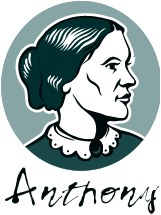
Susan B. Anthony helped get American women the right to vote. She was born in 1820 in Adams, Mass. Her father, Daniel Anthony, was a Quaker and she was brought up as a Friend. Although she was not an active Quaker later in life, she remained a member until she died. Her family moved to Battenberg, N. Y. and her father ran a mill there. Susan attended the local one-room school, where the school master told her that girls did not need
|
to learn long division. She wanted to learn, so she listened secretly while he taught the boys.
When she was 18, she attended Miss Deborah Moulson’s Female Seminary in Pennsylvania. Then she became a teacher herself and taught for about ten years in one-room schools.
She became concerned about social issues, including alcoholism, slavery, and the fact that married women did not control their own money and property. In 1849, she began giving public lectures on temperance, but she was not allowed to speak at a “Sons of Temperance” meeting in 1852 – she was told that women were supposed to “listen and learn.” Like Lucretia Mott, |
Susan also encountered prejudice against women in the anti-slavery movement. Women had to form separate temperance and abolitionist groups in order to be heard.
In 1869, Susan B. Anthony and Elizabeth Cady Stanton formed the National Woman Suffrage Association. For the rest of her life, Susan worked for a constitutional amendment that would give women the right to vote. In 1872, she somehow managed to vote in the presidential election. She was arrested and fined $100, which she refused to pay. Susan traveled around the U.S. and in Europe, lecturing and working for women’s right to vote. She died in 1906. Fourteen years later, the nineteenth |
amendment to the U.S. Constitution was finally ratified. It says, “The right of citizens of the United States to vote shall not be denied or abridged by the United States or by any State on account of sex.”
Sources:
The Constitution of the United States
Mothers of Feminism: The Story of Quaker Women in America, by Margaret Hope Bacon
Susan B. Anthony: Voice for Women’s Voting Rights, by Martha E. Kendall
Susan B. Anthony, Champion of Women’s Rights, by Helen Albee Monsell
“Susan B. Anthony” article in the World Book Encyclopedia |

